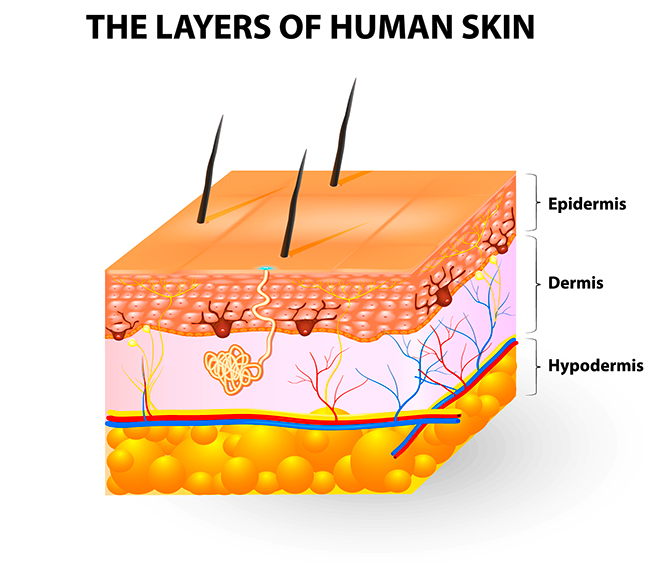The Skin
The skin is the largest organ of the human body, with a total area of about 2m². It protects us from microbes, helps regulate the body temperature, and provides us with the sensation of touch, heat, and cold. Here you will learn about the structure of the
Overview
The skin is the largest organ of the human body. The total area of the skin in an average adult is about 2 square meters and accounts for about 20% of the body weight.

Layers of the Skin
The human skin consists essentially of three superimposed layers. From the outside to the inside, these are called:
The epidermis, the outermost layer of skin, provides a waterproof barrier and creates our skin tone.
The dermis, beneath the epidermis, contains tough connective tissue, hair follicles, and sweat glands.
The hypodermis is the deeper subcutaneous tissue and is made of fat and connective tissue.
Substructure

The epidermis
Between 0.03 mm and 2 mm thick. In the basal layer, basal cells are constantly renewed. After several weeks, these cells penetrate the layers to get to the surface, the horny layer. By this, the epidermis is renewed once a month. Within the epidermis we can also find cells responsible for tanning of the skin (melanocytes), which is a protective reaction to sunlight (UV radiation).
The dermis
The dermis is an elastic and resistant skin layer with a thickness of between 0.5 mm and 1.5 mm. It has small blood vessels (capillaries) and lymph channels passing through it. Additionally, sweat and sebaceous glands (oil glands) are found in the dermis, particularly in the roots of hairs rising from the skin (hair follicles).
The hypodermis
The hypodermis consists mainly of fatty tissue. Depending on the thickness of the fat layer, it is between 0.5 mm and 30 mm thick. First and foremost, it functions as a connecting layer between the upper skin and the dermis (together called cutis) and the underlying muscle tissue, as well as energy storage and isolation.
Function
SHAPE AND FORM
Skin gives the human body an outer shape and form.
PROTECTION
It protects the human organism from the outside world and acts as an important barrier and protector against foreign species (bacteria, viruses, etc.), as well as physical and chemical influences.
SENSES
Through the network of nerve tracts hidden under the skin, humans experience many external senses, such as touch and temperature.
REGULATION
The skin is actively involved in the regulation of the body temperature and body’s water balance (Sweat production).
SYNTHESIS
The skin synthesizes Vitamin D with exposure to sunlight. Additionally, this exposure browns the skin, a protective mechanism against ultraviolet (UV) radiation.

